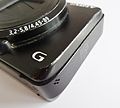This article contains promotional content .(June 2024) |
 | |
| Overview | |
|---|---|
| Maker | Sony |
| Type | Digital still camera + Superzoom camera |
| Lens | |
| Lens | SONY G 25-500mm (20x optical zoom) F3.5 (W) - 5.8 (T) / 40x (with zoom software) |
| Sensor/medium | |
| Sensor | 1/2.3" Exmor R™ CMOS Sensor |
| Maximum resolution | 4,896 X 3,672 (18.9 megapixels) |
| Film speed | ISO 100 - 12800 |
| Storage media | SD, SDHC, SDXC MultiMediaCard, internal |
| Focusing | |
| Focus modes | Multi Point AF / Center Weighted AF / Flexible Spot AF / Manual / Semi Manual / Tracking Focus / Face Tracking Focus |
| Focus areas | (35mm equivalent) : Still 16:9: 27.5-550mm / Still 4:3: 25-500mm / Movie 16:9: 27.5-550mm(SteadyShot Standard), 28-784mm(SteadyShot Active) / Movie 4:3: 34-680mm(SteadyShot Standard), 35-980mm(SteadyShot Active) |
| Focus bracketing | ±2.0 EV in ⅓ EV steps |
| Exposure/metering | |
| Exposure modes | Manual, Program, iAutomatic, Shutter Priority, Aperture Priority, Scene Mode(s) : High Sensitivity / Soft snap / Soft Skin / Landscape / Night Portrait / Night Scene / Handheld Twilight / Gourmet / Beach / Snow / Fireworks /Pet mode /Anti-motion blur / Backlight Correction HDR / Advanced sports shooting |
| Exposure metering | Multi; Center; Spot |
| Metering modes | Intelligent Multiple / Center Weighted / Spot |
| Flash | |
| Flash | ISO Auto: Approx.0.4m to 7.1m(1 feet 3 3/4 inches to 23 feet 3 5/8 inches)(W) / Approx.1.7m to 3.9 m(5feet 7 inches to 12 feet 9 5/8 inches)(T), ISO3200: up to Approx.10.0 m(32 feet 9 3/4 inches)(W) / Approx.5.5 m(18 feet 5/8 inches)(T) |
| Flash bracketing | ±2.0 EV in ⅓ EV steps |
| Shutter | |
| Shutter | Burst Mode : Approx 10 fps at 18.2MP (Maximum 10 shots), Shutter Speeds : iAuto(4" - 1/1600) / Program Auto(1" - 1/1600) / Manual(30" - 1/1600), Self-timer : Off / 10sec. / 2sec. / portrait1 / portrait2, Shutter Response 0.1 seconds Wide - Focus / Shutter Response 0.15 seconds Full zoom - Focus / Shutter Response 0.3 seconds Switch on Time to Taking a Photo 1.8 seconds Shot to Shot (without flash) 1.25 seconds Shot to Shot with Flash 3.6 seconds; Continuous shooting High 6.4 fps; Continuous shooting Low 2 fps |
| Shutter speed range | 0,15 sec - 3,6 sec |
| Continuous shooting | 10 frames per sec. |
| Viewfinder | |
| Viewfinder | 3.0 inch 921K dot LCD screen |
| Image processing | |
| White balance | Auto, Manual, Outdoors/Daylight, Cloudy, Incandescent, Fluorescent, FlashGroup, White Balance |
| General | |
| Battery | Lithium N NP-BG1 3.4 Wh (960 mAh), minimum: 3.3 Wh (910 mAh) (at the beginning 11 °C/ 51.8 °F) Power Requirements : AC 100–240 V, 50/60 Hz, 70 mA |
| Weight | 9.0oz (254g) 4 1/4" x 2 1/2" x 1 3/8" (106.6 x 61.9 x 34.6 mm) |
The camera Sony Cyber-shot DSC-HX20V is a digital camera that was first released in 2012. The Sony Cyber-shot HX20V is part of the Cyber-shot line of cameras released by Sony.






